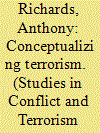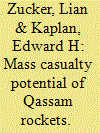|
|
|
Sort Order |
|
|
|
Items / Page
|
|
|
|
|
|
|
| Srl | Item |
| 1 |
ID:
132212


|
|
|
|
|
| Publication |
2014.
|
| Summary/Abstract |
It remains unclear whether the Abu Sayyaf Group (ASG) is a well-structured terror organization that poses a strategic threat, or a loosely organized collection of bandits that poses limited risk. Efforts to assess the nature of the organization are complicated by flaws in existing datasets on Violent Non-State Actors (VNSAs). ASG's role in kidnappings serves as a test-case to estimate incongruities among four major datasets on VNSAs. Original data collected at the agent level provides an additional point of comparison and also serves to test the efficacy of ASG's knowledge-dissemination structures, which are key in determining VNSAs' strategic capacities.
|
|
|
|
|
|
|
|
|
|
|
|
|
|
|
|
| 2 |
ID:
132196


|
|
|
|
|
| Publication |
2014.
|
| Summary/Abstract |
This article argues that, while there have always been good reasons for striving for a universally agreed definition of terrorism, there are further reasons for doing so in the post 9/11 environment, notwithstanding the formidable challenges that confront such an endeavour. Arguing that the essence of terrorism lies in its intent to generate a psychological impact beyond the immediate victims, it will propose three preliminary assumptions: that there is no such thing as an act of violence that is in and of itself inherently terrorist, that terrorism is best conceptualized as a particular method of political violence rather than defined as inherent to any particular ideology or perpetrator, and that non-civilians and combatants can also be victims of terrorism. It will then outline the implications that these assumptions have for the definitional debate.
|
|
|
|
|
|
|
|
|
|
|
|
|
|
|
|
| 3 |
ID:
132209


|
|
|
|
|
| Publication |
2014.
|
| Summary/Abstract |
In spite of the bombardment of southern Israel by thousands of Qassam rockets fired from the Gaza Strip, comparatively few people have been injured or killed. This has led some observers to dismiss Qassams as more of a symbolic than lethal threat. However, southern Israeli towns feature robust civil defense systems that include safe rooms, bomb shelters, early detection alarms, and missile defense. How many casualties would occur were such systems not in place? This article applies shrapnel-casualty and spatial allocation models to the population of the southern Israeli town of Sderot to estimate casualties per randomly aimed rocket fired into the unprepared town; that is, in the absence of civil defense (technical details appear in the Appendix). Assuming an injury radius of only 5 meters from impact, the modeled expected casualties per rocket are between three (best-case) and nine (worst-case) times higher than Sderot's observed casualties-to-rocket ratio, suggesting that Qassam-like terror attacks on unprotected urban locations could prove much more serious than what one would expect based solely on the observed number of casualties in Sderot.
|
|
|
|
|
|
|
|
|
|
|
|
|
|
|
|
| 4 |
ID:
132204


|
|
|
|
|
| Publication |
2014.
|
| Summary/Abstract |
Recent studies have taken an important first step in examining which terrorist groups, based on their organizational characteristics and the characteristics of the environment in which they operate, are more likely to pursue chemical, biological, radiological, and nuclear (CBRN) weapons. This approach, however, assumes that individuals who perpetrate events act on behalf of the organization to which they primarily belong. Using the case of Jemaah Islamiyah's alleged attempt to develop the pathogenic bacterium Bacillus anthracis, or anthrax, the authors demonstrate the importance of including individual-level variables to the analysis. In particular, the attendance by several key Jemaah Islamiyah members at an Al Qaeda-affiliated training camp is argued to set a chain of events into motion that ended in their involvement in the anthrax cultivation program.
|
|
|
|
|
|
|
|
|
|
|
|
|
|
|
|
|
|
|
|
|